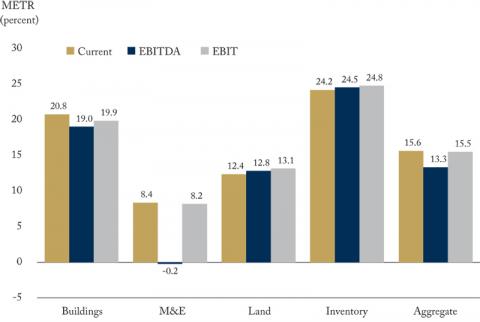From: Philip Bazel and Jack Mintz
To: Canadians concerned about investment
Date: June 8, 2021
Re: The Surprising Investment Impacts from Limiting Net Interest Deductibility
In Budget 2021, the Liberal government moved on its 2019 campaign promise to introduce earning stripping rules, ostensibly to prevent multinational companies from being able to deduct excessive interest expenses in Canada and shift their corporate taxable profits to low-tax jurisdictions.
The complicated proposal mimics similar US and European regimes and is now in Ottawa’s consultation process. It would limit net interest expense deductions above a certain threshold of adjusted taxable income. Much can be said about this rule in terms of its economic, compliance and administrative costs, but here we will specifically focus on its investment impacts.
And some of these include surprising shifts of investment incentives into highly depreciable assets such as machinery and technological equipment, to the detriment of investments in long-lived capital such as buildings.
This is Ottawa’s proposal: Beginning January 1, 2023, net interest expense in excess of 40 percent of taxable earnings before the deduction of interest, taxes, depreciation and amortization (EBITDA) will not be deductible, with the ratio falling to 30 percent after January 1, 2024. Disallowed interest can be carried back three years or carried forward up to 20 years if capacity is available to use deductions. The amount deducted can be expanded if the worldwide ratio of a multinational is higher than the domestic ratio.
Many exemptions would apply. Canadian-controlled private corporations with less than $15 million in assets or corporate groups with less than $250 million in net interest expense would be exempt. In principle, stand-alone, purely domestic Canadian companies or groups would be exempt from the net interest expense limitation although the proposal does not make clear how this will be applied.
As discussed in a C.D. Howe Institute paper last year, the effect of the rule on investment is not as often presumed. At first blush, the EBITDA-based earning-stripping rule would lead to a higher cost of funds, since not all interest expense to fund investment is deductible. This would increase the cost of capital and deter investment. However, companies investing in depreciable assets create greater room to deduct interest under the EBITDA-based stripping rule. This creates an incentive to invest in highly tax depreciable assets to soak up more interest deductions. The latter effect can dominate the former especially for short-lived assets like machinery and equipment.
In contrast, an earning-stripping rule based on taxable earnings before the deduction of interest and taxes only (EBIT) would not have the same effect since investment would not create as much “earnings” room.
We contrast the EBITDA and EBIT-based earnings stripping rule in terms of their impact on the effective tax rate on marginal investments (METR) – the annualized value of corporate income, capital and sales taxes on capital purchases paid by a company as a share of its pre-tax profitability. A METR increase means companies will reduce investment since they cannot earn sufficient profits to attract equity and bond financing from international markets, and decrease acts conversely.
Based on earlier modelling, the Figure shows the METR for Canadian large companies according to the distribution of capital among broad asset classes (aggregated across all industries and provinces.) The first bar is the current system as of 2021. The second shows the impact of the EBITDA-based rule assuming that interest is fully denied for 9.2 percent of investment expenditures. The third is a tax EBIT-based earning stripping rule at 30 percent that would apply to 15.6 percent of investment expenditures.
The results suggest that the impact of the tax EBITDA and EBIT rule would have a surprising impact on capital investment. The METR on capital declines from 15.6 percent to 13.3 percent under the tax EBITDA-based rule. The primary effect is the dramatic decline in the METR on machinery and equipment due to the expansion in taxable EBITDA to soak up interest deductions. In comparison, the aggregate METR on investment falls marginally from 15.6 to 15.5 percent for the EBIT-based rule with the METR slightly declining for structures, machinery and equipment, and slightly rising for inventory and land assets.
Overall, we suggest the EBITDA-based rule is highly distortionary favouring investment in short-lived assets that are already taxed less than other assets. An EBIT-based limitation, which is to be adopted by the United States in 2023, would be less distorting among business activities. Since taxable earnings are smaller under EBIT, we would suggest a higher limit such as 50 percent of EBIT, if the earnings-stripping rule moves ahead.
We realize that the impacts could be mitigated in two ways. Many companies will be able to absorb interest deductions through carry back and forward provisions (we assume that denied interest expense cannot be written off against taxable earnings in other years.) Further, the proposal could include a safe harbour debt-equity ratio such as 1.5 whereby companies with relatively little debt would not be affected.
Even if tax EBIT is used, we do question whether an earnings-stripping rule makes sense for a cyclical economy like Canada given its economic, administrative and compliance costs. At least under EBIT-based rule, the investment impacts are not significant.
Philip Bazel is a research associate at the University of Calgary’s School of Public Policy, where Jack M. Mintz is the President’s Fellow.
To send a comment or leave feedback, click here.
The views expressed here are those of the authors. The C.D. Howe Institute does not take corporate positions on policy matters.






